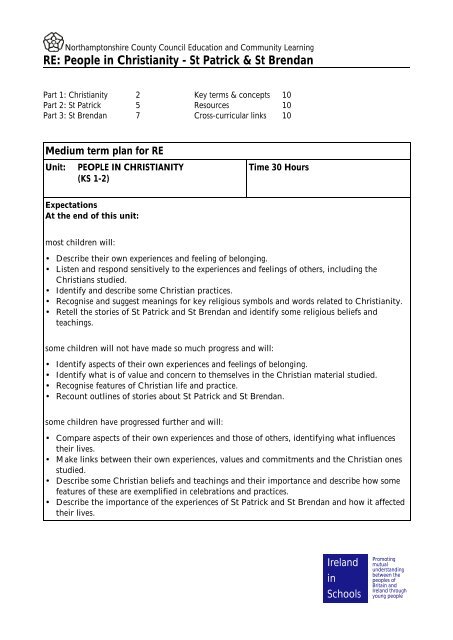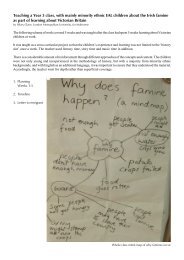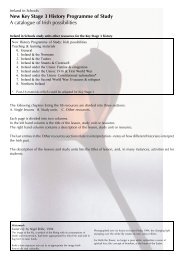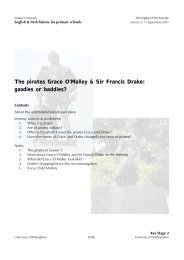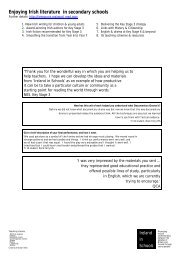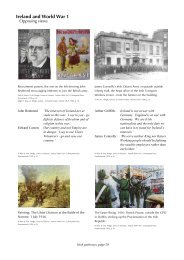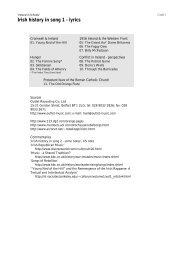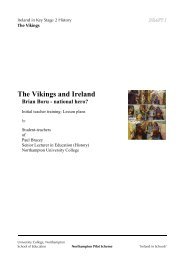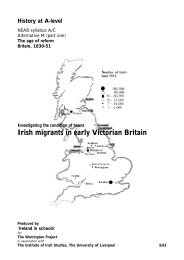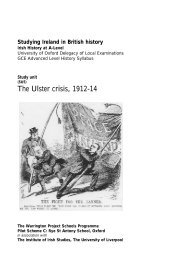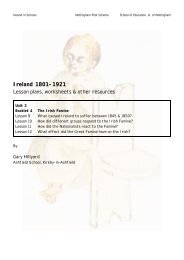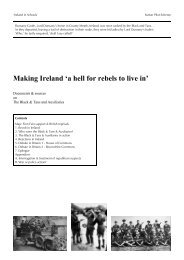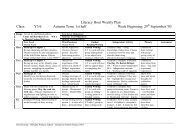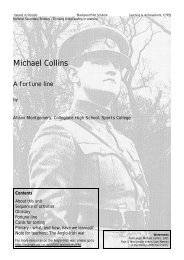RE: People in Christianity - St Patrick & St Brendan - Ireland in Schools
RE: People in Christianity - St Patrick & St Brendan - Ireland in Schools
RE: People in Christianity - St Patrick & St Brendan - Ireland in Schools
Create successful ePaper yourself
Turn your PDF publications into a flip-book with our unique Google optimized e-Paper software.
Northamptonshire County Council Education and Community Learn<strong>in</strong>g<strong>RE</strong>: <strong>People</strong> <strong>in</strong> <strong>Christianity</strong> - <strong>St</strong> <strong>Patrick</strong> & <strong>St</strong> <strong>Brendan</strong>Part 1: <strong>Christianity</strong> 2 Key terms & concepts 10Part 2: <strong>St</strong> <strong>Patrick</strong> 5 Resources 10Part 3: <strong>St</strong> <strong>Brendan</strong> 7 Cross-curricular l<strong>in</strong>ks 10Medium term plan for <strong>RE</strong>Unit:PEOPLE IN CHRISTIANITY(KS 1-2)Time 30 HoursExpectationsAt the end of this unit:most children will:• Describe their own experiences and feel<strong>in</strong>g of belong<strong>in</strong>g.• Listen and respond sensitively to the experiences and feel<strong>in</strong>gs of others, <strong>in</strong>clud<strong>in</strong>g theChristians studied.• Identify and describe some Christian practices.• Recognise and suggest mean<strong>in</strong>gs for key religious symbols and words related to <strong>Christianity</strong>.• Retell the stories of <strong>St</strong> <strong>Patrick</strong> and <strong>St</strong> <strong>Brendan</strong> and identify some religious beliefs andteach<strong>in</strong>gs.some children will not have made so much progress and will:• Identify aspects of their own experiences and feel<strong>in</strong>gs of belong<strong>in</strong>g.• Identify what is of value and concern to themselves <strong>in</strong> the Christian material studied.• Recognise features of Christian life and practice.• Recount outl<strong>in</strong>es of stories about <strong>St</strong> <strong>Patrick</strong> and <strong>St</strong> <strong>Brendan</strong>.some children have progressed further and will:• Compare aspects of their own experiences and those of others, identify<strong>in</strong>g what <strong>in</strong>fluencestheir lives.• Make l<strong>in</strong>ks between their own experiences, values and commitments and the Christian onesstudied.• Describe some Christian beliefs and teach<strong>in</strong>gs and their importance and describe how somefeatures of these are exemplified <strong>in</strong> celebrations and practices.• Describe the importance of the experiences of <strong>St</strong> <strong>Patrick</strong> and <strong>St</strong> <strong>Brendan</strong> and how it affectedtheir lives.<strong>Ireland</strong><strong>in</strong><strong>Schools</strong>Promot<strong>in</strong>gmutualunderstand<strong>in</strong>gbetween thepeoples ofBrita<strong>in</strong> and<strong>Ireland</strong> throughyoung people
Outl<strong>in</strong>e Plann<strong>in</strong>g Sheet for Religious EducationUnit Ref: Key <strong>St</strong>ages 1-2 Title: <strong>People</strong> <strong>in</strong> <strong>Christianity</strong> Part 1: <strong>Christianity</strong>Key Questions Learn<strong>in</strong>g Objectives Activities Learn<strong>in</strong>gOutcome/AssessmentWhat is it like tobelong to a group?• To know that we allbelong to differentgroups.• To consider the role weplay <strong>in</strong> groups.• Children look at pictures of different ‘family’groups, match<strong>in</strong>g labels to identifycharacters. (Avoid stereotypes of family, raceetc. Include pets.)• Children draw and label members of theirhousehold.• As a circletime activity discuss roles thatmembers of their households play. How dothey support/care for each other?• Complete simple sentences to expla<strong>in</strong> howwe can care for each other as members of ahousehold.• Discuss belong<strong>in</strong>g to other groups such asthe class, Brownies, Cubs, other clubs etc.What do they have to do as a member of thegroup? What shows they belong to thegroup? (Clothes, promises, badge etc.)• Children are given one ‘group’ to make asimple display, show<strong>in</strong>g all they have learnedabout belong<strong>in</strong>g to it.Pupils• Use their ownexperience toidentify whatis <strong>in</strong>volved <strong>in</strong>belong<strong>in</strong>g to ahousehold.• Identify ways<strong>in</strong> which theydemonstratebelong<strong>in</strong>g to agroup.Who belongs tothe schoolfamily?• To know that lots ofpeople make up theschool community.• A large jigsaw puzzle should be made and cutfrom polystyrene or similar material.• Discuss people that make up the schoolcommunity. Identify their roles andimportance.• Identify whatis <strong>in</strong>volved <strong>in</strong>belong<strong>in</strong>g to alargercommunity.• Small groups take a piece of the jigsaw anddraw/label one of the people/groupsidentified. They write an explanation of theircontribution to the school community.Jigsaw pieces are fitted together to make alarger display.• Discussion should focus on the value ofeveryone <strong>in</strong> the community.NCC Education, <strong>RE</strong> (KS1-2): Sa<strong>in</strong>ts, 2
Key Questions Learn<strong>in</strong>g Objectives Activities Learn<strong>in</strong>gOutcome/AssessmentWhat is it liketo belong to<strong>Christianity</strong>?• To know that there aremany different roles <strong>in</strong>the Christian Church.• To become familiar withkey words associatedwith the ChristianChurch.• Children watch a video of Sarah and Paulgo<strong>in</strong>g to church.• Discuss the people that were seen <strong>in</strong> thechurch and their roles.• Put a large picture of a church on display.On the left side cut and stick shapes labelledwith the people <strong>in</strong>volved <strong>in</strong> the church. Moreable pupils could be given another religiousbuild<strong>in</strong>g and people associated with it andasked to look for similarities and differenceswith the church.• Read, ‘Lucy’s Sunday’, from Bridges toReligion series. Discuss what Lucy enjoysabout the church, what activities is she<strong>in</strong>volved <strong>in</strong>? Discuss what other activities thechildren th<strong>in</strong>k/know happen <strong>in</strong> churches.• Have a selection of pictures of Christianworship / activities <strong>in</strong> Church, such as awedd<strong>in</strong>g, Baptism, Harvest etc. Partly coverthe each picture so that some is left show<strong>in</strong>g.Ask the children, <strong>in</strong> small groups, to drawwhat they th<strong>in</strong>k is covered up.• What do they th<strong>in</strong>k is happen<strong>in</strong>g? Picturesare then uncovered and groups report backabout how accurate they were, what cluesthere were, what surprised them etc.• They then study the picture and compose 5 -10 statements about what is happen<strong>in</strong>g.These can be written or taped. After thisthey form up to 5 questions they would needto ask <strong>in</strong> order to tell people more abouttheir picture.• More able pupils can be given <strong>in</strong>formation tof<strong>in</strong>d answers to their questions throughsimple text, access to CD Roms etc. Otherscould be supported <strong>in</strong> f<strong>in</strong>d<strong>in</strong>g out the detailsneeded. Pictures and <strong>in</strong>formation gatheredcould then be displayed or presented to theclass or to an assembly.• Return<strong>in</strong>g to the picture of the church on thewall - pictures or labels of activities that takeplace <strong>in</strong> the church could be recorded, cutout and placed down the right hand side ofthe picture. A list of key words should alsobe compiled and displayed nearby.Pupils will• Know the keypeople<strong>in</strong>volved <strong>in</strong> theChurchCommunity.• if they arecapable, canmakecomparisonbetween thechurchcommunityand anotherreligion.• Can describethe ma<strong>in</strong>activities thattake placewith<strong>in</strong> achurch.• Can identifykey wordsassociated withthe church.NCC Education, <strong>RE</strong> (KS1-2): Sa<strong>in</strong>ts, 3
Key Questions Learn<strong>in</strong>g Objectives Activities Learn<strong>in</strong>gOutcome/AssessmentWhat does it feellike <strong>in</strong>side achurch?• To identify some of thema<strong>in</strong> features of achurch.• To reflect upon andrespond to be<strong>in</strong>g <strong>in</strong>side achurch.• Arrange a visit to a church. Allow thechildren to sit quietly <strong>in</strong>side the church anduse their senses. How do they feel? Whatcan they see, hear, smell etc? They shouldtape or write their feel<strong>in</strong>gs and use this as abasis for a ‘senses’ poem:I see...I hear...I smell...I taste ... .I am ...• Investigate the parts of the church and askthe children to draw, tape or write about theth<strong>in</strong>g they found most <strong>in</strong>terest<strong>in</strong>g and toexpla<strong>in</strong> why.Pupils• Reflect on thefeatures andfeel<strong>in</strong>gsassociatedwith thechurch.• Identify<strong>in</strong>terest<strong>in</strong>gfeatures of thechurch.• On return to school these experiences shouldbe shared. What different th<strong>in</strong>gs did theyfeel, see as most <strong>in</strong>terest<strong>in</strong>g etc?How does aVicar feel abouthis job?• To be aware of how aclergy person sees theirjob.• To ask questions andrespond with respect andsensitivity to a memberof the Christian faith.• Prior to the visit of a vicar or other clergyperson, work with the children on prepar<strong>in</strong>ga set of questions for the visit. L<strong>in</strong>k to ICTand word process the questions. Put them ondisplay for the visit.• Ask the vicar or other clergy to talk of theirrole, why they chose that ‘job’ and to answerthe questions.• Follow<strong>in</strong>g the visit reproduce the answers toput with the questions on display.• Respond withsensitivity tothe values andbeliefs of theClergy person.• Realise thatsomequestionscause peopleto wonder andare difficult toanswer.• L<strong>in</strong>k ICT skillswith <strong>RE</strong>.NCC Education, <strong>RE</strong> (KS1-2): Sa<strong>in</strong>ts, 4
Outl<strong>in</strong>e Plann<strong>in</strong>g Sheet for Religious EducationUnit Ref: Key <strong>St</strong>ages 1-2 Title: <strong>People</strong> <strong>in</strong> <strong>Christianity</strong> Part 2: <strong>St</strong> <strong>Patrick</strong>Key Questions Learn<strong>in</strong>g Objectives Activities Learn<strong>in</strong>gOutcome/AssessmentWho was <strong>St</strong><strong>Patrick</strong>?• To become familiar withthe patron sa<strong>in</strong>t of<strong>Ireland</strong> - <strong>St</strong> <strong>Patrick</strong>.• To be aware of ways <strong>in</strong>which beliefs can affectbehaviour.• Prepare a storysack with objects related to <strong>St</strong><strong>Patrick</strong> - e.g. shamrock, Bible, cross, map of<strong>Ireland</strong>, a toy sheep, a model boat, piratesoutfit, pictures of slaves, Roman co<strong>in</strong>s,Priests robe or Collar, book of prayers etc.• Show each of the objects to the children oneat a time and ask them what clues we haveabout the person we’re go<strong>in</strong>g to learn about.Where might he be from? When did he live?What job could he have done? What religiondid he belong to? Etc.• Show a large picture of <strong>St</strong> <strong>Patrick</strong> be<strong>in</strong>gcaptured. What are his thoughts? Childrenfill <strong>in</strong> speech bubbles and discuss.• Tell a simple version of the story of <strong>St</strong><strong>Patrick</strong>. Have paper plates with differentfaces express<strong>in</strong>g feel<strong>in</strong>gs of happ<strong>in</strong>ess,sadness, fear, excitement etc. Ask thechildren to select the most appropriate faceat certa<strong>in</strong> parts of the story to show how<strong>Patrick</strong> might have been feel<strong>in</strong>g. Questionthem as to why they th<strong>in</strong>k that.Pupils• Identify withthe feel<strong>in</strong>gs ofthe characterof <strong>St</strong> <strong>Patrick</strong> <strong>in</strong>the story.• Can retell thekey details ofthe story of <strong>St</strong><strong>Patrick</strong>.• Can expla<strong>in</strong>what they feelto be the mostimportantparts of thestory.• To reflect upon andrespond to questions ofmean<strong>in</strong>g and value.• Watch the animated tale of <strong>St</strong> <strong>Patrick</strong> tore<strong>in</strong>force the story.• Give the children a blank ‘video cover’ andask them to devise a title for the story toreflect what it is all about and write thedetails for the ‘blurb’ of the cover (depend<strong>in</strong>gon their ability this could be one simplesentence or a longer passage).• Ask the children to run the story throughtheir head like a video and stop it at whatthey th<strong>in</strong>k is the most important part of thestory and to expla<strong>in</strong> why they th<strong>in</strong>k that.They could draw the scene on a blank ‘TVscreen’ or more able pupils could write/tapetheir justification.• Identify ways<strong>in</strong> whichbeliefs affectbehaviour.• Respond to <strong>St</strong><strong>Patrick</strong>’sbless<strong>in</strong>g andreflect uponwhat hopesthey have fortheirfamily/friends/themselves.• Discuss what <strong>St</strong> <strong>Patrick</strong>’s ma<strong>in</strong> beliefswere. Why did he act as he did? Relate toexamples from children’s experiences aboutwhy they or people around them behave asthey do.• Look at a variety of pictures of <strong>St</strong> <strong>Patrick</strong> bydifferent artists. Which do they th<strong>in</strong>k aremost likely to be accurate? Why? Which dothey like/dislike? Why? More able pupilscould select a picture and complete an‘images’ worksheet. Discuss whether picturesare the best way to f<strong>in</strong>d out about whatsomebody is like.NCC Education, <strong>RE</strong> (KS1-2): Sa<strong>in</strong>ts, 5
Key Questions Learn<strong>in</strong>g Objectives Activities Learn<strong>in</strong>gOutcome/Assessment• L<strong>in</strong>k to the children’s experience by ask<strong>in</strong>gthem to br<strong>in</strong>g <strong>in</strong> photographs of themselves.Comb<strong>in</strong>e these with photographs of a varietyof famous people and people <strong>in</strong> school etc.Do the photographs reveal anyth<strong>in</strong>g aboutthe person? Do the clothes matter? Etc. Canwe really tell what the person is like?• Read <strong>St</strong> <strong>Patrick</strong>’s bless<strong>in</strong>g. Discuss what itmeans. Who is he concerned about?Children compose their own‘bless<strong>in</strong>gs’/thoughts about what they hopefor their friends/family. Children share theirthoughts if they wish to.• Expla<strong>in</strong> how the church recognises Sa<strong>in</strong>ts’Days and how to many countries these daysare very important. <strong>People</strong> are often namedafter Sa<strong>in</strong>ts and, <strong>in</strong> Italy for example, villageshave grand celebrations when the Sa<strong>in</strong>t towhom their village/church is dedicated hastheir day. Look at some of thecustoms/celebrations associated withcelebrat<strong>in</strong>g <strong>St</strong> <strong>Patrick</strong>’s Day particularly <strong>in</strong><strong>Ireland</strong> e.g. The Parade <strong>in</strong> Dubl<strong>in</strong>.• Prepare the class/school for a celebration of<strong>St</strong> <strong>Patrick</strong>’s Day. Invite parents and otherguests. Invite Irish Dancers to work with thechildren to devise simple dances to perform.Have Irish cookery lessons with food toshare, prepare a puppet play ordramatisation of <strong>St</strong> <strong>Patrick</strong>’s life and haveIrish songs and bless<strong>in</strong>gs. Involve guests <strong>in</strong>mak<strong>in</strong>g cards to send greet<strong>in</strong>gs on <strong>St</strong><strong>Patrick</strong>’s Day and generally celebrate<strong>Ireland</strong>! L<strong>in</strong>k, via e-mail, with schools <strong>in</strong><strong>Ireland</strong> to see how they are celebrat<strong>in</strong>g theday.• Follow<strong>in</strong>g the event, reflect on how it felt toparticipate <strong>in</strong> the celebrations and evaluatethe experience.Pupils• Know that thechurchcelebratesSa<strong>in</strong>ts’ Days.• Experienceparticipation <strong>in</strong>festivities.• Become awareof a broaderpicture of<strong>Ireland</strong>.• Evaluate theirfeel<strong>in</strong>gs/experiences.NCC Education, <strong>RE</strong> (KS1-2): Sa<strong>in</strong>ts, 6
Outl<strong>in</strong>e Plann<strong>in</strong>g Sheet for Religious EducationUnit Ref: Key <strong>St</strong>ages 1-2 Title: <strong>People</strong> <strong>in</strong> <strong>Christianity</strong> Part 3: <strong>St</strong> <strong>Brendan</strong>Key Questions Learn<strong>in</strong>g Objectives Activities Learn<strong>in</strong>gOutcome/AssessmentWho was <strong>St</strong><strong>Brendan</strong>?• To know the story ofanother Irish Sa<strong>in</strong>t.• To understand howpeople can be motivatedby their beliefs.• Follow up work on <strong>St</strong> <strong>Patrick</strong> with a focus onanother religious Irish character such as <strong>St</strong>Colmcille, <strong>St</strong> Brigid or <strong>St</strong> <strong>Brendan</strong>. I will beus<strong>in</strong>g <strong>St</strong> <strong>Brendan</strong> here, as an example.• Tell the story of <strong>St</strong> <strong>Brendan</strong>. Retell as achorus drama where the teacher narrates asimple version of the story and the class forma chorus with relevant actions/ words/ soundsto re<strong>in</strong>force key features of the story. Forexample:T There was once a young man whoplanned a journey.C Let’s go, beep, beep, aeroplane sounds,(parade <strong>in</strong> a l<strong>in</strong>e round class).T He found some friends to go with him.C Hello, Hi, How are you?T They built a boat.C Bang, Bang, Hammer, Saw.T They packed supplies.C Mmm yum yum.T They set sail.C Whoosh, whoosh etc.• Discuss the key po<strong>in</strong>ts of the story. Why did<strong>Brendan</strong> behave as he did? What must thejourney have been like? Why didn’t he giveup?• Show pictures of the mysterious events ofthe journey. Children suggest what may bebe<strong>in</strong>g said by characters and fill <strong>in</strong> speechbubbles to accompany the pictures. Discusswhy such th<strong>in</strong>gs would have seemed sostrange then.• L<strong>in</strong>k to children’s own experience by hav<strong>in</strong>gphotographs of everyday objects taken fromstrange angles or show<strong>in</strong>g only part of theobject. Discuss how th<strong>in</strong>gs seem strangeuntil we are familiar with them.Pupils• Can retell thekey elements ofthe story of <strong>St</strong><strong>Brendan</strong>.• Reflect on whyth<strong>in</strong>gs may seemto be strange/mysterious topeople.NCC Education, <strong>RE</strong> (KS1-2): Sa<strong>in</strong>ts, 7
Key Questions Learn<strong>in</strong>g Objectives Activities Learn<strong>in</strong>gOutcome/AssessmentWhat was <strong>St</strong><strong>Brendan</strong>’svoyage like?• To reflect on the feel<strong>in</strong>gsof <strong>St</strong> <strong>Brendan</strong>.• To express feel<strong>in</strong>gsthrough music.• To be aware that beliefscan be expressed <strong>in</strong>different forms.• Display a map of <strong>Brendan</strong>’s journey. <strong>St</strong>ickpictures or words on it to show/describe thefeel<strong>in</strong>gs at each stage of the journey.• Devise a story bowl together. What wouldthe <strong>in</strong>gredients be to tell the story of <strong>St</strong><strong>Brendan</strong>? What characters?, Feel<strong>in</strong>gs? etc.• Show the children an empty envelopeaddressed to ‘My dear friend, Enda’. Expla<strong>in</strong>that the letter, from <strong>Brendan</strong>, has gonemiss<strong>in</strong>g. Decide where on the journey it waswritten and compose a letter together. Itshould show <strong>Brendan</strong>’s fears, hopes,excitement, etc. Depend<strong>in</strong>g on ability,children could then compose another letterfor a different stage of the journey on theirown or with support.Pupils...• Identify thefeel<strong>in</strong>gs of <strong>St</strong><strong>Brendan</strong>.• Empathisewith thefeel<strong>in</strong>gs of <strong>St</strong><strong>Brendan</strong>.• Listen to short extracts from ‘The <strong>Brendan</strong>Voyage’ by Shaun Davey.• Ask the children to close their eyes and th<strong>in</strong>kabout the music. What pictures does it br<strong>in</strong>gto their m<strong>in</strong>ds? Why might that be? Discussthe <strong>in</strong>struments used. Draw the th<strong>in</strong>gs thatcome to their m<strong>in</strong>ds and discuss. Do theyth<strong>in</strong>k the extracts relate to specific parts of<strong>Brendan</strong>’s journey? Which? Why?• Ask the children, <strong>in</strong> small groups, to makeup sounds/music to represent differentfeel<strong>in</strong>gs, such as, anger, excitement, sadness,happ<strong>in</strong>ess, peace, fear. Whatobjects/<strong>in</strong>struments would they choose tomake the sounds? Why? Would the soundsbe loud / soft? Fast/slow? Etc. Oncecomposed the children could write simplepoems about their emotions to read withtheir ‘music’. This could be performed to theclass or an assembly.• Imag<strong>in</strong>e that you could go back <strong>in</strong> time andmeet <strong>St</strong> <strong>Brendan</strong>. What questions would thechildren like to ask him? As well as simpledetails encourage questions on feel<strong>in</strong>gs andreasons for his actions. Teacher <strong>in</strong> the role of<strong>St</strong> <strong>Brendan</strong> then takes the hot seat andanswers questions put to them from thechildren, giv<strong>in</strong>g as much detail as possibleabout him. A role on the wall of <strong>Brendan</strong>should then be created, gather<strong>in</strong>g all the<strong>in</strong>formation learned about him together. (Asimple outl<strong>in</strong>e of a person is drawn anddetails written around the outside. Feel<strong>in</strong>gsare written <strong>in</strong>side the outl<strong>in</strong>e).• Interpretfeel<strong>in</strong>gs/eventsexpressedthrough music.• Expressemotions,symbolicallythrough music.• Are aware thatmusic cansymboliseemotions.• Be becom<strong>in</strong>gaware thatbeliefs can beexpressedthroughdifferentforms.NCC Education, <strong>RE</strong> (KS1-2): Sa<strong>in</strong>ts, 8
Key Questions Learn<strong>in</strong>g Objectives Activities Learn<strong>in</strong>gOutcome/AssessmentWhat have welearned about <strong>St</strong><strong>Brendan</strong>?• To produce a bookabout <strong>St</strong> <strong>Brendan</strong>.• Children <strong>in</strong>dividually, or <strong>in</strong> groups, use<strong>in</strong>formation to make zigzag books or bigbooks entitled, ‘Who was <strong>St</strong> <strong>Brendan</strong>?’Depend<strong>in</strong>g on their ability this might besequenced pictures, a few simple statementsor a more detailed collection of pictures andwrit<strong>in</strong>g <strong>in</strong>clud<strong>in</strong>g detail of why <strong>Brendan</strong> didwhat he did.Pupils• Synthesise<strong>in</strong>formationga<strong>in</strong>ed throughdrama andstory to form apicture of thelife of <strong>St</strong><strong>Brendan</strong>.Why do webehave as we do?• To make simplecomparisons between <strong>St</strong><strong>Patrick</strong> and <strong>St</strong> <strong>Brendan</strong>and the motivationbeh<strong>in</strong>d their actions.• To be aware of ways <strong>in</strong>which beliefs motivatebehaviour.• Encourage the children to look forsimilarities between the two Sa<strong>in</strong>ts studied.Identify the reasons beh<strong>in</strong>d their venturesand l<strong>in</strong>k to the children’s experiences of whythey behave as they do. Follow up workcould <strong>in</strong>clude look<strong>in</strong>g at modem dayChristians who have been motivated by theirbeliefs.• Identifysimilarities/differencesbetween thelives/motivations of<strong>St</strong> <strong>Patrick</strong> and<strong>St</strong> <strong>Brendan</strong>.• L<strong>in</strong>kexperiencesfrom the livesof the Sa<strong>in</strong>tswith their ownbehaviour/motivations.NCC Education, <strong>RE</strong> (KS1-2): Sa<strong>in</strong>ts, 9
Key Terms Key Concepts Resources Cross CurricularL<strong>in</strong>ks eg SMSC /Literacy / NumeracyBaptismCelebrationChurchHarvest<strong>Ireland</strong>Journey<strong>St</strong> <strong>Brendan</strong><strong>St</strong> <strong>Patrick</strong>SymbolVicarVoyageWedd<strong>in</strong>gWorshipBeliefBelong<strong>in</strong>gCelebrationCommitmentCommunityFaithFamilyPrayerReflectionWorshipPolystyrene Jigsaw‘Sarah and Paul’ Video (crossview)‘Lucy’s Sunday’ book fromBridges to Religion SeriesPictures of members of house<strong>in</strong>clud<strong>in</strong>g petsLabels of members of householdLarge pictures of churchPictures of Christian Worship<strong>St</strong> <strong>Patrick</strong>’s bless<strong>in</strong>g‘<strong>Patrick</strong> - Brave Shepherd of theEmerald Isle’ video (<strong>St</strong> Paulmultimedia)<strong>St</strong>ories about <strong>St</strong> <strong>Patrick</strong>Photographs of famous peoplePhotographs of people <strong>in</strong> theschoolVisit of a ClergypersonVisit to a Church<strong>St</strong>ory sack for <strong>St</strong> <strong>Patrick</strong><strong>St</strong>ory of <strong>St</strong> <strong>Brendan</strong>Pictures of <strong>St</strong> <strong>Brendan</strong>’s voyageMap of <strong>St</strong> <strong>Brendan</strong>’s journey‘Issues’ sheet‘The <strong>Brendan</strong> Voyage’ Musicby Shaun DaveyRange of objects / percussion<strong>in</strong>struments.HistoryLiteracyDramaMusicICTCD-ROMSWord Process<strong>in</strong>gUse of InternetE-mail l<strong>in</strong>ks with <strong>Ireland</strong> schoolsNCC Education, <strong>RE</strong> (KS1-2): Sa<strong>in</strong>ts, 10


